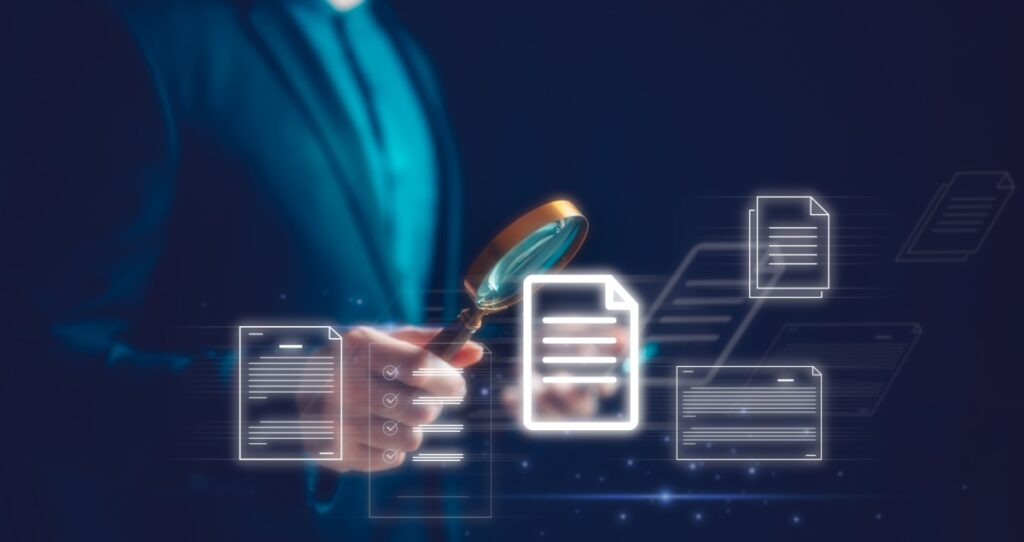Glossary of eDiscovery Terms for Litigation

As a lawyer, you are accustomed to reading, speaking, and interpreting the complex language of the law. It’s a skill honed over years of study and practice. Despite this, the terminology of eDiscovery can feel like learning a whole new language. That’s why we’ve compiled a list of the most common eDiscovery terms you should know. This glossary will help you communicate more effectively with clients, opposing counsel, and litigation support vendors. Of course, this list isn’t exhaustive, as eDiscovery is always evolving. Fortunately, our expert litigation support team is here to help you navigate the entire discovery process successfully, from preservation to production.
Core Concepts
Electronically Stored Information (ESI): ESI is any data that is in a digital format. This includes emails, documents, spreadsheets, databases, social media posts, voicemails, and data from mobile devices.
Electronic Discovery: This is simply another term for eDiscovery and describes the process of identifying, preserving, collecting, reviewing, and producing electronically stored information (ESI) in the context of a legal matter.
Digital Forensics: The practice of collecting, examining, and analyzing digital evidence in a forensically sound manner to preserve its integrity. Digital forensics is often required when there are concerns about data tampering, deletion, or when data needs to be recovered from damaged devices.
Custodian: An individual who has possession, custody, or control of potentially relevant ESI (often because it resides on their devices or within their email accounts). Identifying the correct custodians at the outset of a matter is a crucial first step.
Litigation Hold (or Legal Hold): A formal notice sent to an organization and specific custodians to preserve all forms of relevant information, including ESI, in anticipation of or pending litigation. Failure to do so can lead to accusations of spoliation.
Spoliation: The intentional, reckless, or negligent withholding, hiding, altering, or destroying of evidence relevant to a legal proceeding. Spoliation can result in severe sanctions, including adverse inference instructions or even default judgments.
Metadata: Often called “data about data,” metadata is the information that describes the history, tracking, and management of an electronic document. Common examples include a file’s creation date, last modified date, author, and file path. This information can be critical for authenticating evidence.
Data Mapping: The process of identifying and inventorying an organization’s ESI systems and storage locations. A data map helps legal teams understand where potentially relevant data resides, who the custodians are, and how data is stored and managed.
Chain of Custody: A chronological record documenting the handling of evidence. It details who collected, controlled, transferred, and analyzed the ESI to guarantee the evidence’s authenticity and integrity in court.
The eDiscovery Process
Meet and Confer: A mandatory meeting between opposing parties, typically early in the litigation process, to discuss the discovery plan. Topics often include the scope of discoverable ESI, preservation methods, search terms, and the format of production.
Discovery Request: A formal request from one party to another for the production of documents, ESI, or other tangible things relevant to the lawsuit.
Early Case Assessment (ECA): An initial analysis of the ESI in a matter to understand the key facts, custodians, data volumes, and potential risks and costs. ECA helps legal teams develop a case strategy and budget for discovery early on.
Clawback Agreement: An agreement between parties that sets forth procedures for handling the inadvertent production of privileged documents. If a privileged document is accidentally produced, this agreement allows the producing party to “claw it back” and have it returned without waiving privilege.
Collection: The process of gathering ESI from various sources (e.g., computers, servers, mobile devices) for further use in the eDiscovery workflow. It is vital that collection is done in a forensically sound manner to preserve the integrity of the data and its metadata.
Processing: The stage where collected ESI is converted into a format suitable for review and analysis. This step often includes extracting text and metadata, performing Optical Character Recognition (OCR) on image-based files, and deduplication.
Data Extraction: A sub-process of processing where text, metadata, and other information are pulled from native files to be indexed in a database for searching and review.
De-NISTing: A filtering step during processing that removes common system files (e.g., .exe, .dll) based on a list maintained by the National Institute of Standards and Technology (NIST). This reduces the amount of non-user-generated data that needs to be reviewed.
Deduplication: A process that identifies and removes exact duplicate documents from the ESI collection. This reduces the volume of documents that need to be reviewed, saving time and money.
Culling: The process of reducing the volume of ESI using various criteria, such as date ranges, file types, or keywords, to eliminate clearly irrelevant documents before the main review begins.
Normalization: The process of converting data from different sources and formats into a consistent, standard format for review.
Review: The systematic evaluation of documents to determine their relevance to the case, whether they contain privileged information, or if they need to be redacted.
Technology-Assisted Review (TAR): An advanced process that uses artificial intelligence and machine learning (often called predictive coding) to help lawyers find relevant documents faster and more accurately than a manual, linear review.
Production: The formal delivery of relevant, non-privileged ESI to the opposing party in a legally approved format. Documents are often produced as TIFF or PDF images with an accompanying load file that contains metadata and extracted text.
Technical Terms
Repository: A central location where data is stored and managed. In eDiscovery, this is often a secure database or platform where processed ESI is hosted for review.
Archival Data: Information that is no longer in active use but is stored for long-term retention, often on backup tapes or in the cloud. Accessing and restoring archival data can be time-consuming and costly.
Legacy Data: Information stored in an old or obsolete format or on an outdated system that is difficult to access with modern technology.
Native File: A file in its original format, as it was created and maintained by the application that generated it (e.g., a Microsoft Word document in .docx format or an Excel spreadsheet in .xlsx format).
Bates Stamping: The process of applying unique, sequential alphanumeric identifiers to each page of a document production. This ensures that every page has a distinct reference, which is essential for depositions and trial.
Optical Character Recognition (OCR): A technology that converts images of text (like a scanned document or a PDF) into machine-readable, searchable text. Without OCR, you cannot search the content of image-based files.
Hash Value: A unique digital fingerprint created by applying a mathematical algorithm to a file. If even a single character in the file is changed, the hash value will change, making it a reliable method for verifying that a file is an exact duplicate and has not been altered.
Boolean Search: A type of search that allows users to combine keywords with operators like AND, OR, and NOT to narrow down or broaden search results, providing more precise control over the search process.
Master Key eDiscovery Terms & Master Litigation
Electronic discovery is one of the most critical components of the litigation process, as the ability to properly identify, preserve, process, and present electronically stored information can significantly influence the outcome of a case. While understanding key eDiscovery terms is an essential first step toward improving your litigation efforts, putting that knowledge into practice requires experience, precision, and the right tools. You can get all of this by partnering with Cornerstone Discovery.
Our experts have mastered not only the language of eDiscovery but the practice of it as well. We support litigators by providing a full suite of services, including:
- Digital Forensics and Data Collection
- eDiscovery Processing and Hosting
- Managed Document Review
- Technology-Assisted Review (TAR) Consulting
- Trial Presentation Services
- And More!
Let our team provide the technical expertise and strategic guidance you need to handle your client’s data defensibly and efficiently. To learn more about how we can support your practice, contact us today.


